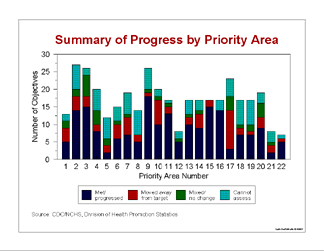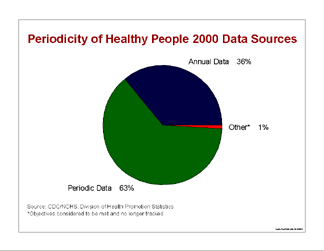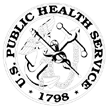
The Deputy Assistant Secretary for Health
(Disease Prevention and Health Promotion) and the HHS Principal
Deputy Assistant Secretary for Planning and Evaluation jointly
chaired a review of progress on objectives for surveillance and
data systems. This briefing commenced the third round in the
on-going series of reviews covering the 22 priority areas of
Healthy People 2000. Progress on the seven objectives in priority
area 22 is described below.
22.1 Eighteen health status indicators
(HSI) were established in 1991. These include nine mortality
measures, three birth indicators, four infectious disease rates,
and two other indicators. Fifty States and the District of
Columbia were monitoring some HSI's in 1993; the year 2000 target
of 40 States has been met. Thirty-six States were providing HSI
data to local health departments in 1992. The target is 40.
National data for HSI's are published annually in the Healthy
People 2000 Review by race and Hispanic origin. State HSI
data can be found on the World Wide Web through the National
Center for Health Statistics home page
(http://www.cdc.gov/nchswww/nchshome.htm).
22.2 In the baseline year 1990, 77
percent of year 2000 national health objectives had data sources
to measure progress. In 1996, 98 percent had such sources. Since
there are no baselines and no plans for data collection for 7 of
the 319 objectives, the year 2000 target of 100 percent has
effectively been achieved. In addition, 74 percent of the
objectives now have at least one update. In 1997, State year 2000
plans had been published by 44 States, the District of Columbia
and Guam. The target is 50 States.
22.3 Twenty-one percent of Federal,
State and local agencies in 1994 collected comparable data for
selected year 2000 objectives, an increase from 12 percent in
baseline year 1990. The year 2000 target is 100 percent.
Objectives monitored with the National Vital Statistics System,
the Youth Risk Behavior Survey, the Notifiable Disease
Surveillance System, and the Fatal Accident Reporting System are
based on State data. Objectives monitored with the National
Health Interview Survey were also counted if the State Behavioral
Risk Factor Surveillance System included comparable questions.
22.4 Identifying significant gaps in the
Nation's disease prevention/health promotion data is an on-going
process. Through the midcourse review, 111 new special population
subobjectives were added because of new data becoming available
that identified health disparities.
22.5 This objective measures the results
of State data collection efforts. The year 2000 target for vital
statistics data was met by the 1989 baseline of 50 States plus
the District of Columbia. Since 1994, all States have conducted a
Behavioral Risk Factor Survey. The number of States collecting
and publishing hospital discharge data increased from 22 in 1989
to 29 in 1996. For Youth Risk Behavior Survey data, there was an
increase from 24 States in 1989 to 43 in 1993, and a subsequent
decline to 40 in 1995. In 1996, 22 States analyzed and published
data on their progress toward the national or State-specific
objectives for each racial or ethnic group making up at least 10
percent of the State population. The baseline was 19 States in
1992 and the year 2000 target is 25.
22.6 The year 2000 target for
electronically transferring information related to the national
health objectives among Federal, State and local agencies has
been met. The National Electronic Telecommunications System for
Surveillance has provided weekly data on cases of nationally
notifiable diseases to the Centers for Disease Control and
Prevention since 1989. The Public Health Laboratory Information
System has been used in all States since 1994 to share data for
epidemiologic, laboratory, survey, case-control and most other
public health data needs. DATA2000, available to all Internet
users, is an electronic database containing the national baseline
and monitoring data for each Healthy People 2000 objective and
special population subobjective, as well as the Health Status
Indicators.
22.7 Timeliness in the release of
national surveillance and survey data reflects the proportion of
objectives that have updates for a particular year. This
proportion varies with the periodicity of data collection
mechanisms. Progress has been made in releasing preliminary data
from the National Vital Statistics System within 1 year of
collection instead of the 2 years it has taken in the past.
HIGHLIGHTS
- In 1996, 8 percent of the 319 unduplicated
Healthy People 2000 objectives had reached or surpassed
their targets; 40 percent had progressed toward the
targets; 18 percent showed movement away from the target;
5 percent showed mixed results; and 3 percent showed no
change from the baseline. Seventy-five objectives (20
percent) have baseline data but no new data with which to
evaluate progress. Baselines have yet to be obtained for
19 objectives (6 percent).
- Data are now available to provide annual
updates on 36 percent of the Healthy People 2000
objectives. Another 63 percent of the objectives can be
updated periodically.
- The Health Insurance Portability and
Accountability (Kennedy-Kassebaum) Act of 1996 is
expected to provide a major impetus for new electronic
data transmission standards and for data linkage and
integration.
- The electronic birth record has
accelerated the flow of data from hospitals through
States to the National Center for Health Statistics.


FOLLOW-UP
- Involve State and local governments at
every stage of national data collection, analysis and
dissemination. Approaches to this include adding
questions to existing national surveys rather than
creating new surveys; oversampling special population
groups; designing and conducting surveys that measure
interventions; and developing a data collection mechanism
that can be utilized by multiple levels of government.
- Translate national data sets into more
user-friendly forms for States and communities. Employ
means such as-increasing access to publications through
electronic media; increasing availability of data through
the Internet and CD-ROM; communicating with State health
departments regarding forthcoming data releases. Apply
geocoding to national health surveys, vital statistics
reporting, the Behavioral Risk Factor Surveillance
System, and Hospital Discharge data sets.
- Provide technical assistance to the 500+
Indian tribal governments to enhance their capacity to
collect health-related data.
- Examine linkages between socio-economic
status and health risks to give a more complete picture
of the effects of poverty on health.
- Collaborate with the private sector to
scale their information to the community level. In
addition, ensure that community-level public health data
are available to private health care providers.
- Explore the feasibility of establishing a
data collection block grant or setting aside a portion of
the block grants for data activities.
- Proactively address confidentiality
requirements to ensure the integrity of all data
collection activities.
- Achieve greater coordination and pooling
of data resources across agency lines within DHHS to
strengthen the Department's data activities. In addition,
achieve better linkages between census data and other
program data.
- In developing health promotion/disease
prevention objectives for 2010, give greater attention to
State and local priorities. Consider identifying these as
an adjunct to the national objectives.
- Monitor the impact on the collection of
survey data of the Congressional mandate to reduce the
Federal reporting burden by 25 percent over the next 3
years.
PARTICIPANTS
American Public Health Association
Centers for Disease Control and Prevention
Food and Drug Administration
Health Care Financing Administration
Health Resources and Services Administration
Illinois Department of Health
Indian Health Service
Institute of Medicine/National Academy of Sciences
Maryland Department of Health and Mental Hygiene
Minnesota Department of Health
National Committee on Quality Assurance
National Institutes of Health
Office of the Assistant Secretary for Management and Budget
Office of the Assistant Secretary for Planning and Evaluation
Office of Disease Prevention and Health Promotion
Office of Intergovernmental Affairs
Office of Management and Budget
Office of Minority Health
Oregon Health Department
Pro-West
Regional Health Administrator/Region I
Substance Abuse and Mental Health Services Administration
University of Washington School of Public Health*
Wake County (NC) Department of Human Services
* Also representing Robert Wood Johnson Foundation


Jo Ivey Boufford, M.D.
Acting Assistant Secretary for Health
Back to Progress Review Page